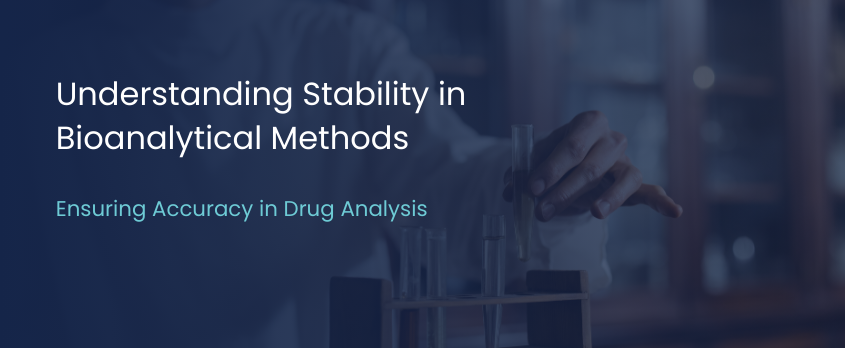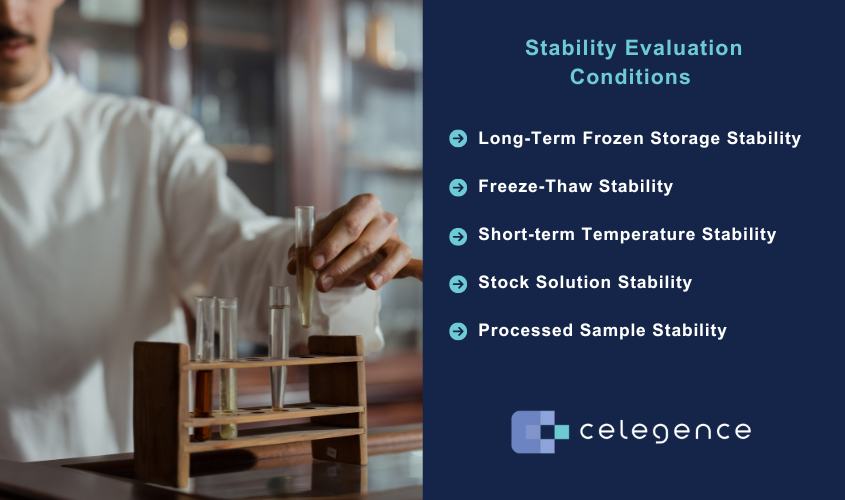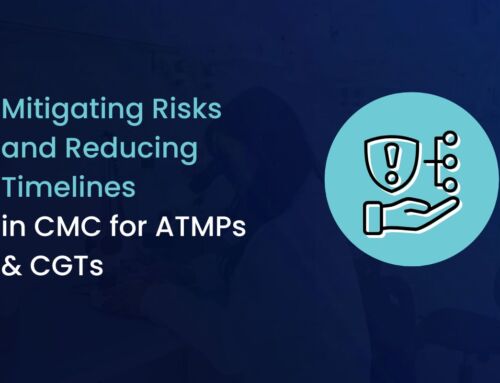
Stability Assessments as a Part of Bioanalytical Method Validation
Bioanalytical methods are developed and used in drug development studies to provide accurate and reliable measurements of drug concentrations in clinical and nonclinical study samples from biological matrices like plasma or serum. Before these methods are used on actual study samples, many undergo validation assessments to ensure their reliability and accuracy. One category of validation assessments oftentimes includes the stability of the analytes (drug or metabolite).
Importance of Assessing Stability During Method Validation
During validation, quality control (QC) samples (also known as stability samples when they are specifically slated for stability assessments) will be stored in various conditions for differing periods of time and then analyzed to assess the stability of the analytes during those storage conditions. Small molecules, such as traditional small-molecule drugs, can be susceptible to various degradation pathways, including hydrolysis, oxidation, and photolysis. Large molecules, such as therapeutic proteins and monoclonal antibodies, can be affected by physical and chemical instabilities, including denaturation, aggregation, and chemical modifications. Thus, stability assessments are important evaluations during method validation because instability can lead to inaccurate results, potentially compromising the interpretation of the data and subsequent decision-making for the drug development program.
A Note on Quality Control Samples and Nominal Concentrations
QC samples differ from actual study samples. QC samples are samples with a known concentration of the analyte; this known concentration is also referred to as a nominal concentration (see ensuing paragraph below). They are typically prepared by spiking matrix (e.g., human plasma or serum) with the analyte at specific concentration levels by scientists at the analytical laboratory. The use of QC samples provides the scientists with a measure of how well the method is performing, especially when that method is used to measure actual study samples of unknown concentrations that are drawn from study participants.
Nominal (also referred to as theoretical) concentrations refer to the expected (or known) concentration of the analyte in a QC sample. The nominal concentrations are typically chosen to span the anticipated concentration range of the actual study samples, including low, medium, and high concentrations. These QC samples serve as reference points to evaluate the accuracy and precision of the bioanalytical method during validation and subsequent sample analysis. In simplest terms, if a plate containing a mix of actual study samples (unknown concentrations) and QC samples (known concentrations) returns expected QC sample results that meet the acceptance criteria, then there is reason to believe the method is performing as intended and the results returned for the unknown study samples are accurate and reliable, and therefore acceptable.
Stability Evaluation Conditions
Study samples are oftentimes shipped to the bioanalytical laboratory from other laboratories or clinics. Upon arrival, they may need to be stored in freezers for various periods of time before they can be processed and analyzed. As a result, the stability of small and large molecules can be evaluated with QC samples under various conditions that mimic the handling and storage of actual study samples. These conditions can include but are not limited to:
- Long-Term Frozen Storage Stability: QC samples are stored at the intended long-term storage temperature (typically -20°C or -80°C) for an extended period, oftentimes exceeding the expected study duration. This assessment is made to determine how stable the analyte remains during long-term frozen storage. It can be vital for drug studies that span several months or years.
- Freeze-Thaw Stability: When study samples are thawed for analysis, only a necessary amount is drawn from the sample’s container. The container with the sample’s unused remainder is placed back into the freezer. But there are times when actual study samples will need to be re-analyzed. As such, they are again removed from the freezer and thawed again. During method validation, QC samples will oftentimes undergo multiple freeze-thaw cycles, mimicking the potential handling of study samples during analysis. This evaluation is important because repeated freezing and thawing can potentially degrade the analyte, leading to inaccurate concentration measurements.
- Short-term Temperature Stability: QC samples are generally exposed to refrigerated (2-8°C) and room temperature conditions for a defined period, simulating the potential temperature excursions that may occur during sample handling, processing, and analysis. This assessment is helpful in determining how effective the method might be in quantitating analytes that have undergone temporary temperature deviations, as well as the stability of the analyte under the same conditions.
- Stock Solution Stability: The stability of the analyte in a general stock solution used for preparing QC samples will typically also be evaluated. This assessment determines the reliability of the stock solutions after storage and can be reliably used for additional lots of QC sample preparation over an extended period.
- Processed Sample Stability: In some cases, the stability of the analyte in processed samples (e.g., after protein precipitation or solid-phase extraction) may also be evaluated. Oftentimes samples require extensive processing prior to their analysis. This assessment is particularly important when samples cannot be analyzed immediately after processing and need to be stored temporarily before analysis.

Stability Assessment Criteria
The stability of the analyte is generally evaluated by comparing the measured concentrations of the QC samples at each stability condition to the nominal (known) concentrations. Regulatory agencies, such as the FDA and EMA, provide guidelines on the acceptable criteria for stability. Typically, the mean concentration of the stability QC samples should be within ±15% (or ±20% at the lower limit of quantitation) of the nominal concentration for small molecules, whereas ±20% (or ±25% at the lower limit of quantitation) might be used in large molecule assessments.
Some Measures to Take when Instability is Observed
If the analyte is found to be unstable in QC samples under any of the evaluated conditions, appropriate measures can be taken to maintain the integrity of the actual study samples. These measures may include (but are not limited to):
- Adjusting Sample Handling Procedures: If instability is observed at certain temperatures or after multiple freeze-thaw cycles, sample handling procedures may need to be modified to minimize exposure to these conditions.
- Shortening Reanalysis Window: If instability is observed during short-term temperature exposure, the reanalysis window (the time allowed for sample analysis after thawing) may need to be shortened to minimize potential degradation.
- Implementing Stabilization Strategies: In some cases, stabilization strategies, such as the addition of stabilizing agents or adjusting pH, may be employed to improve the analyte’s stability.
- Modifying Storage Conditions: If instability is observed during long-term frozen storage, the storage temperature may need to be lowered (e.g., from -20°C to -80°C) to improve stability.
- Adjusting Sample Analysis Sequence: If instability is observed in processed samples, the analysis sequence may need to be adjusted to minimize the time between sample processing and analysis.
Reporting of Stability Assessments
The quantitative results of the analyte in QC samples are generally reported as a part of a validation report. Pharmaceutical companies will sometimes differ in what stability details they require their bioanalytical partners to present in the validation report. For example, many companies will require that only the measurements taken at each time point (i.e., number of days of storage or number of freeze/thaw cycles) be reported in a table, with their results compared against the nominal concentration as a measure of accuracy. Other companies might require that each time point be presented alongside the data from the same lot of QC samples when analyzed on the same day the lot was prepared (e.g., Day-0 results compared against Day-365 results). The common theme, however, is the actual results from each time point or condition are presented in the report. Despite the varying requirements from Sponsors, it is generally considered a good practice to, at the very least, list the number of days of storage, describe the storage conditions, and to briefly describe the procedure for calculating the precise number of days.
Conclusion
The stability assessment is a key component of bioanalytical method validation for drug development studies. By evaluating the stability of small and large molecules under various conditions, scientists, management, and regulators involved in the drug development process are one step closer to the goal of reporting results that are of the highest possible accuracy and reliability. This ultimately supports sound decision-making throughout the process. Proper stability assessment not only contributes to the integrity of the study data but also contributes to the overall quality and regulatory compliance of the bioanalytical methods that are will be used for measuring study samples with concentrations that are unknown at the time of receipt at the laboratory.
Celegence’s Expertise: Your Partner for Expert Bioanalytical Services
Led by CEO Sonia Veluchamy, Celegence has in its network many full-time writers and consultants who come from a variety of scientific backgrounds. One area of expertise is in the regulated bioanalytical space. By maintaining this network, Celegence has been able to provide services in support of client programs that require knowledge of many writing processes related to regulated bioanalysis. One topic that remains of interest is incurred sample reanalysis (ISR).
We can be reached at info@celegence.com or contact us online for more information.
Author
This blog post is written by Jean-François Cazorla, our Scientific Writing Consultant, who has extensive experience and expertise in the field of regulated bioanalytical report writing. Jean’s 20+ years in the field includes overseeing the regulated QC and writing divisions in bioanalytical CRO environments, as well as the individual production of regulated bioanalytical documents for 250+ biopharmaceutical sponsors. During this time, he was involved in small and large molecule bioanalytical programs, with emphasis on producing immunogenicity and pharmacokinetic validation and sample analysis reports. He is currently a consultant for Celegence helping a major documentation contract with a Sponsor developing gene therapies.


